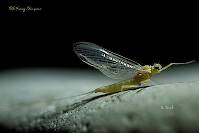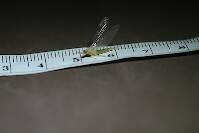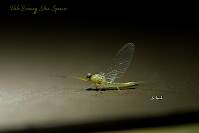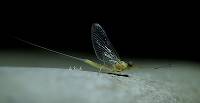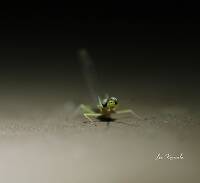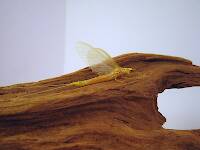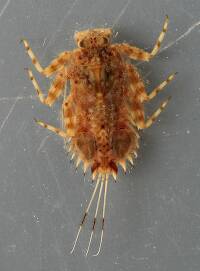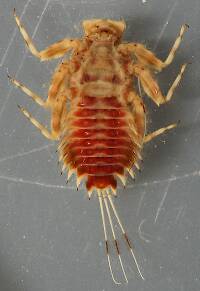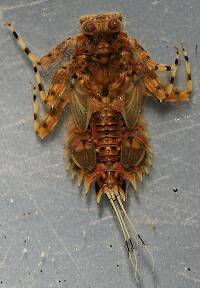
Salmonflies
Pteronarcys californica
The giant Salmonflies of the Western mountains are legendary for their proclivity to elicit consistent dry-fly action and ferocious strikes.
Featured on the forum

Nymphs of this species were fairly common in late-winter kick net samples from the upper Yakima River. Although I could not find a key to species of Zapada nymphs, a revision of the Nemouridae family by Baumann (1975) includes the following helpful sentence: "2 cervical gills on each side of midline, 1 arising inside and 1 outside of lateral cervical sclerites, usually single and elongate, sometimes constricted but with 3 or 4 branches arising beyond gill base in Zapada cinctipes." This specimen clearly has the branches and is within the range of that species.

Troutnut is a project started in 2003 by salmonid ecologist Jason "Troutnut" Neuswanger to help anglers and
fly tyers unabashedly embrace the entomological side of the sport. Learn more about Troutnut or
support the project for an enhanced experience here.
Entoman on Nov 26, 2012November 26th, 2012, 3:59 pm EST
Why are several forms of Drunella grandis held as separate subspecies while other species' forms that look to be even more disparate are not? Especially when they (grandis ssp.) look to be so close morphologically as to be virtually indistinguishable and even intergrate in areas where their ranges overlap. There are many examples of species that seem to be treated differently (E. excrucians, S. interpunctatum, M. vicarium, to name a few) whose forms establish either discrete populations with little evidence (if any) of intergrating or exist in isolation. The morphological differences seem more pronounced as well. Why aren't their forms considered "subspecies" when the cases seem even stronger in some respects? Is the current taxonomy inconsistently embracing lumping for some taxa and splitting for others?
Thought it would be fun to put this topic up for discussion...
Thought it would be fun to put this topic up for discussion...
"It's not that I find fishing so important, it's just that I find all other endeavors of Man equally unimportant... And not nearly as much fun!" Robert Traver, Anatomy of a Fisherman
Konchu on Nov 27, 2012November 27th, 2012, 4:20 pm EST
I'll take the ball, here.
Different species groups have been treated by different people in different times. Thus, there have been different approaches to the concepts of species and subspecies.
From my 2010 paper on Caudatella:
"The subspecies classifications, in particular, are questionable because they were established at a time when mayfly taxonomists tended to define any distinct morphological variant as a nominal subspecies; currently, subspecies designations usually are reserved for geographically isolated variants."
http://www.hindawi.com/journals/psyche/2010/493935/
From the 2012 paper on DNA barcoding:
"Some of these species are clearly species complexes, with well-defined and deeply divergent clusters with associated morphological differences (i.e. Maccaffertium mexicanum integrum). The non-monophyletic species are also likely species complexes as preliminary examination of some, such as Baetis tricaudatus Dodds, show morphological variation corresponding to barcode clusters. Most of the species with very large intraspecific distances have at least one synonym. ... Our results indicate that much more taxonomic work is required on North American Ephemeroptera as many currently recognized species include several highly divergent, often polyphyletic, haplotypes, usually correlated with morphological differentiation among lineages. Most of these species have complex histories of synonymy, reflecting a 60 year trend in North American mayfly systematics towards inclusive species concepts. This trend was driven by the observation of individuals morphologically intermediate between named species, or by observations suggesting that members of one species fell within ‘the expected range of variation’ of another. Nearly all of these decisions of synonymy were based only on limited morphological studies, without consideration of biogeographic, ecological, behavioral or molecular data. While this fusion of species has simplified morphology-based identifications, it now seems likely that this trend often ignored biological reality. For example, the four species in the Drunella lata complex were all synonymized under Drunella lata (Morgan) based on morphological study, but morphometric, ecological, and allozyme data indicates at least three species in the northeastern United States. Our results confirm this conclusion and amplify it by indicating that D. longicornis (Traver) likely also represents a valid species in the complex and that there is a fifth species in the southeastern United States."
http://www.plosone.org/article/info%3Adoi%2F10.1371%2Fjournal.pone.0038063
Supplemental material (Text S-1) in the latter paper includes commentary and philosophical discussion about many of the problematic species groups.
Ball back in your court.
Different species groups have been treated by different people in different times. Thus, there have been different approaches to the concepts of species and subspecies.
From my 2010 paper on Caudatella:
"The subspecies classifications, in particular, are questionable because they were established at a time when mayfly taxonomists tended to define any distinct morphological variant as a nominal subspecies; currently, subspecies designations usually are reserved for geographically isolated variants."
http://www.hindawi.com/journals/psyche/2010/493935/
From the 2012 paper on DNA barcoding:
"Some of these species are clearly species complexes, with well-defined and deeply divergent clusters with associated morphological differences (i.e. Maccaffertium mexicanum integrum). The non-monophyletic species are also likely species complexes as preliminary examination of some, such as Baetis tricaudatus Dodds, show morphological variation corresponding to barcode clusters. Most of the species with very large intraspecific distances have at least one synonym. ... Our results indicate that much more taxonomic work is required on North American Ephemeroptera as many currently recognized species include several highly divergent, often polyphyletic, haplotypes, usually correlated with morphological differentiation among lineages. Most of these species have complex histories of synonymy, reflecting a 60 year trend in North American mayfly systematics towards inclusive species concepts. This trend was driven by the observation of individuals morphologically intermediate between named species, or by observations suggesting that members of one species fell within ‘the expected range of variation’ of another. Nearly all of these decisions of synonymy were based only on limited morphological studies, without consideration of biogeographic, ecological, behavioral or molecular data. While this fusion of species has simplified morphology-based identifications, it now seems likely that this trend often ignored biological reality. For example, the four species in the Drunella lata complex were all synonymized under Drunella lata (Morgan) based on morphological study, but morphometric, ecological, and allozyme data indicates at least three species in the northeastern United States. Our results confirm this conclusion and amplify it by indicating that D. longicornis (Traver) likely also represents a valid species in the complex and that there is a fifth species in the southeastern United States."
http://www.plosone.org/article/info%3Adoi%2F10.1371%2Fjournal.pone.0038063
Supplemental material (Text S-1) in the latter paper includes commentary and philosophical discussion about many of the problematic species groups.
Ball back in your court.
Entoman on Nov 27, 2012November 27th, 2012, 5:55 pm EST
Fascinating, Luke. Thanks for the response.
Yes, that makes sense. It is what I suspected.
Man, intergrades sure are a monkey wrench in the works if the hope was an easily defined taxonomy! :) Makes one wonder if it's even possible. Heck, I guess it isn't, strictly speaking. Nature doesn't seem to want to be put in little boxes.
Hmmm... Too much splitting followed by too much lumping? But I gather from your commentary that general trends aside, in reality it's a little more complex in that both have occasionally occurred simultaneously depending on the taxa, data available, and the worker.
BTW - Is barcoding in essence, simply a more precise study of morphologial detail? It seems to me that comparing DNA strings and leg structures are essentially engaging in the same activity, it's just that the former is taking a closer look...
Is it possible (hopeful) that the gathering and interpreting of genetic sequencing data will eventualy be refined to the point that most of the subjectivity regarding species concepts will be removed? Or does their have to be more consensus as to what constitutes specific relationships first? Perhaps the two go hand in hand and it isn't a chicken or egg first question...
Sorry for all the questions, but I can't help myself (think I've said that before).:)
Edit - Missed your reference! Oh well... For those interested, I created a link for it in Konchu's post. VERY informative...
Ah, can't wait! (even if there is a movie, Spence) :)
Different species groups have been treated by different people in different times. Thus, there have been different approaches to the concepts of species and subspecies.
Yes, that makes sense. It is what I suspected.
This trend was driven by the observation of individuals morphologically intermediate between named species, or by observations suggesting that members of one species fell within ‘the expected range of variation’ of another.
Man, intergrades sure are a monkey wrench in the works if the hope was an easily defined taxonomy! :) Makes one wonder if it's even possible. Heck, I guess it isn't, strictly speaking. Nature doesn't seem to want to be put in little boxes.
Nearly all of these decisions of synonymy were based only on limited morphological studies, without consideration of biogeographic, ecological, behavioral or molecular data. While this fusion of species has simplified morphology-based identifications, it now seems likely that this trend often ignored biological reality.
Hmmm... Too much splitting followed by too much lumping? But I gather from your commentary that general trends aside, in reality it's a little more complex in that both have occasionally occurred simultaneously depending on the taxa, data available, and the worker.
BTW - Is barcoding in essence, simply a more precise study of morphologial detail? It seems to me that comparing DNA strings and leg structures are essentially engaging in the same activity, it's just that the former is taking a closer look...
Is it possible (hopeful) that the gathering and interpreting of genetic sequencing data will eventualy be refined to the point that most of the subjectivity regarding species concepts will be removed? Or does their have to be more consensus as to what constitutes specific relationships first? Perhaps the two go hand in hand and it isn't a chicken or egg first question...
Sorry for all the questions, but I can't help myself (think I've said that before).:)
Edit - Missed your reference! Oh well... For those interested, I created a link for it in Konchu's post. VERY informative...
DNA barcoding results cannot only serve as a guide of where to focus these efforts, but also be used as part of an iterative revisionary process [32] together with morphological, ecological, and behavioral characteristics to achieve stable, robust species hypotheses.
Ah, can't wait! (even if there is a movie, Spence) :)
"It's not that I find fishing so important, it's just that I find all other endeavors of Man equally unimportant... And not nearly as much fun!" Robert Traver, Anatomy of a Fisherman
Oldredbarn on Nov 27, 2012November 27th, 2012, 5:56 pm EST
Luke...I think I'll wait to see the movie. :)
I think the short of it is...In earlier times entomologist were working more in isolation than they are now and info travelled at a slower pace. Now info moves at a good clip and we all can get on the web and communicate with a guy in Russia for example instantly...Add DNA info and the whole ball of wax has to be in flux waiting for it all to shake out...
These times they are a changing, no...
The only real struggle is when you add in us impatient anglers...The pseudo-entomologists. :)
I've had some nice PM's between myself and Roger lately about how my romantic attachment to old traditional species names is no less scientific than when I was hung up on terms like Blue-Winged Olives, Pale Evening Dun, Iron fraudator...:)
Spence
I think the short of it is...In earlier times entomologist were working more in isolation than they are now and info travelled at a slower pace. Now info moves at a good clip and we all can get on the web and communicate with a guy in Russia for example instantly...Add DNA info and the whole ball of wax has to be in flux waiting for it all to shake out...
These times they are a changing, no...
The only real struggle is when you add in us impatient anglers...The pseudo-entomologists. :)
I've had some nice PM's between myself and Roger lately about how my romantic attachment to old traditional species names is no less scientific than when I was hung up on terms like Blue-Winged Olives, Pale Evening Dun, Iron fraudator...:)
Spence
"Even when my best efforts fail it's a satisfying challenge, and that, after all, is the essence of fly fishing." -Chauncy Lively
"Envy not the man who lives beside the river, but the man the river flows through." Joseph T Heywood
"Envy not the man who lives beside the river, but the man the river flows through." Joseph T Heywood
Konchu on Nov 28, 2012November 28th, 2012, 4:48 am EST
Is barcoding in essence, simply a more precise study of morphologial detail? It seems to me that comparing DNA strings and leg structures are essentially engaging in the same activity, it's just that the former is taking a closer look...
I've been pushing this point for a number of years now, especially in class. Study of DNA is really morphological study at a very fine level. It's just more complicated due to those structures being directly heritable, relatively easily mutated, potentially transferred from different species via viruses, etc. One also has to be careful about contamination or amplification of DNA from other organisms, such as bacteria, archaea, protozoa, etc., affiliated with the target of study. Basically unknowingly looking at the wrong specimen.
Is it possible (hopeful) that the gathering and interpreting of genetic sequencing data will eventually be refined to the point that most of the subjectivity regarding species concepts will be removed?
I don't know that subjectivity can ever be removed from the picture. But we all can try to play by more similar and more stringent rules for applying that subjectivity.
Another thing to remember is that species are hypotheses and really represent the grouping of populations (the natural units that actually evolve) into a single bin by people. Different people will sort into different bins or different numbers of bins. This leads back to the point above about trying to find some common, similar rules for sorting. But this can be dangerous, especially if everyone winds up using a poor set of rules. So, some diversity of methodology, etc., is important for the health of the science and our attempts to approximate reality. This is a science, and therefore taxonomic hypotheses are something that need to be tested, retested and revised. Much of systematics falls under the aegis of observational science, but many of its end results are hypotheses that then are subject to hypothesis-driven science. Observations simply are what they are, but hypotheses are something to be chipped away at continually. Here's a quick schematic of how the scientific method works: observation -> question -> hypothesis -> prediction -> experiment -> things diverge from here. If the experimental results support the hypothesis (science never really proves anything), then you make additional predictions and test them. If your experimental results do not support your hypothesis, then you need to revise or replace your hypothesis.
Given the nature of what a species is, or rightly is not, and the nature of the scientific method of inquiry, this process will never really cease or achieve any permanent stability. Nor should it! Dogma and truth are for other areas of life. This is one reason that I'm wary when folks say they trust science, or that science is truth. Methinks they misunderstand.
All that being said, however, Iron fraudator is today as much of a real entity as it was when its description came out in 1935. A lot of people don't think about this. It has a scientific description that adheres to the rules and limitation of the International Code of Zoological Nomenclature, and it has a type specimen that serves as its "permanent" (nothing of this world really is permanent) reference. Some folks just choose to call it Epeorus pleuralis.
You may call me Terry, you may call me Timmy
You may call me Bobby, you may call me Zimmy
You may call me R.J., you may call me Ray
You may call me anything but no matter what you say...
Apologies to Bob Dylan, but I had to slip that in there; this was just getting way too heavy for this early in the day.
Crepuscular on Nov 28, 2012November 28th, 2012, 4:56 am EST
I for one would love to see the movie. I see some really cool potential there.
Joking aside (although I may not really be joking about the movie), the genetic work, as I see it meshes quite well with the morphological data and I see an extremely valuable outcomes especially in the ecological roles these species play in various geographical locations around the world. For someone like me the development of a more robust dataset of species ( and you can name those species anything you want, it doesn't seem to affect the roles that they play in aquatic systems) composition cannot do anything but assist in creating better indices of tolerances to impacts to our surface waters. Just as in the past as these types of metrics used aquatic invertebrates at the family level to assess water quality, the tolerance variation of specific genera varies greatly as we know now rendering those family-based indices, virtually useless outside of a middle school science class. Especially when these datasets are used in a regulatory manner. Which, I would assume, is one of the reasons why, Luke is doing the fascinating work he is doing.
Joking aside (although I may not really be joking about the movie), the genetic work, as I see it meshes quite well with the morphological data and I see an extremely valuable outcomes especially in the ecological roles these species play in various geographical locations around the world. For someone like me the development of a more robust dataset of species ( and you can name those species anything you want, it doesn't seem to affect the roles that they play in aquatic systems) composition cannot do anything but assist in creating better indices of tolerances to impacts to our surface waters. Just as in the past as these types of metrics used aquatic invertebrates at the family level to assess water quality, the tolerance variation of specific genera varies greatly as we know now rendering those family-based indices, virtually useless outside of a middle school science class. Especially when these datasets are used in a regulatory manner. Which, I would assume, is one of the reasons why, Luke is doing the fascinating work he is doing.
Oldredbarn on Nov 28, 2012November 28th, 2012, 8:39 am EST
Luke...You seem to think quite clearly "early" in the morning. :) If you ask me. Great discription of the process and why the process...Good stuff!
I'm printing it actually...It needs to be in Spence's pile in the fishing corner. :) Along with Roger's update of my old "Mayflies of Michigan Trout Streams".
Its all about the dialectic :) Thesis/Antithesis/Synthesis and it starts all over again...Thank you Socrates or Marx or whomever...
It is interesting to me your concern about extraneous variables having an effect on things. Nothing is simple, is it?! No need to fear uncertainty, just be aware of those things that could be clouding our observations.
Keep up the good work and keep stirring the pot in class...It just may lead us somewhere important.
Thanks for your thoughts here.
Spence
I'm printing it actually...It needs to be in Spence's pile in the fishing corner. :) Along with Roger's update of my old "Mayflies of Michigan Trout Streams".
Its all about the dialectic :) Thesis/Antithesis/Synthesis and it starts all over again...Thank you Socrates or Marx or whomever...
It is interesting to me your concern about extraneous variables having an effect on things. Nothing is simple, is it?! No need to fear uncertainty, just be aware of those things that could be clouding our observations.
Keep up the good work and keep stirring the pot in class...It just may lead us somewhere important.
Thanks for your thoughts here.
Spence
"Even when my best efforts fail it's a satisfying challenge, and that, after all, is the essence of fly fishing." -Chauncy Lively
"Envy not the man who lives beside the river, but the man the river flows through." Joseph T Heywood
"Envy not the man who lives beside the river, but the man the river flows through." Joseph T Heywood
Entoman on Nov 28, 2012November 28th, 2012, 9:42 am EST
Great stuff, Luke!
I agree, Eric. These studies really are vital to working out a sustainable balance between consuming the natural resources required by our civilization and preserving as much as possible of the natural world.
I agree, Eric. These studies really are vital to working out a sustainable balance between consuming the natural resources required by our civilization and preserving as much as possible of the natural world.
"It's not that I find fishing so important, it's just that I find all other endeavors of Man equally unimportant... And not nearly as much fun!" Robert Traver, Anatomy of a Fisherman
Konchu on Nov 28, 2012November 28th, 2012, 10:50 am EST
I actually used this thread in class today. We were talking about taxonomy/systematics and biotechnology. Put a couple folks to sleep; another wants to do research with me now. A lot of in between. But all who left came back.
Oldredbarn on Nov 29, 2012November 29th, 2012, 4:41 am EST
But all who left came back.
Curiosity kills the cat...But if it fails to kill the cat, he just may have learned something. :)
Yesterday I printed the link that Kurt put out there and read it. It was the McCafferty & Huff piece, "The Life Cycle of the Mayfly Stenacron Interpunctatum". Very interesting stuff! It was a bit of an eye opener for me. The idea of "multi-broods" basically maturing around the same time and some lavae basically over-wintering etc...I think most of the general population of anglers have a concept of eggs being deposited around the same time and maturing/emerging one year later...
A couple seasons back I was sitting one evening with a friend on the upper Manistee just west of Grayling. He dipped his net into a muck bank and pulled out a couple Hex nymphs. One was nearly twice as big as the other. We thought that one was maybe next years emerger and the other maybe the following year...Now I'm not so sure.
It makes a great deal of sense to me that during the winter months that growth/development would slow down a great deal, but I never imagined it to work as discribed here.
Thanks!
Spence
"Even when my best efforts fail it's a satisfying challenge, and that, after all, is the essence of fly fishing." -Chauncy Lively
"Envy not the man who lives beside the river, but the man the river flows through." Joseph T Heywood
"Envy not the man who lives beside the river, but the man the river flows through." Joseph T Heywood
Konchu on Nov 29, 2012November 29th, 2012, 5:01 am EST
Your observations attest to some important questions. Sometimes these asynchronous broods are thought to be single species, other times different ones. If they're different, they usually are extremely closely related. I think it is a way of seeing species in the throes of evolution. Time can be an effective reproductive barrier for obligate sexual organisms.
Entoman on Nov 29, 2012November 29th, 2012, 8:18 am EST
The idea of "multi-broods" basically maturing around the same time and some lavae basically over-wintering etc...
What's also cool is the paper's mention of evidence that eggs deposited on the same day can lead to emergences over a period of six weeks! Compound that by eggs being laid over six weeks and it's easier to understand why so many heptageniid's hatches are strung out, rarely providing us poor anglers fishable hatches even though their nymphs are very abundant in samples.
I think it is a way of seeing species in the throes of evolution. Time can be an effective reproductive barrier for obligate sexual organisms.
Ah! Perhaps inciting the organism to a parthenogenetic response? This seems to be more common among mayfly species than once thought. I've noticed a dearth of males in many hatches of late... Like an individuals response to stress by increasing its respiration prior to death, perhaps both the above are also signs of a stressed species in the throes of extinction as well? Even though the parthenogenesis isn't obligate, the lack of male genetic material in large segments of the populations can't be helpful in terms of adaptability and long term survival, can it?
"It's not that I find fishing so important, it's just that I find all other endeavors of Man equally unimportant... And not nearly as much fun!" Robert Traver, Anatomy of a Fisherman
Oldredbarn on Nov 29, 2012November 29th, 2012, 6:02 pm EST
Ok boys! You have my attention and I'll get back with you once I've consulted my dictionary first. :) You are a little north of my pay grade.
Spence
Kurt...How about rearing Hex from egg to adult in 79 days! Or giving Caucci and Nastasi a nod in the abstract? How do I get to read Murphy's (1922) discussion on my beloved Baetis vagans?
Spence
Kurt...How about rearing Hex from egg to adult in 79 days! Or giving Caucci and Nastasi a nod in the abstract? How do I get to read Murphy's (1922) discussion on my beloved Baetis vagans?
"Even when my best efforts fail it's a satisfying challenge, and that, after all, is the essence of fly fishing." -Chauncy Lively
"Envy not the man who lives beside the river, but the man the river flows through." Joseph T Heywood
"Envy not the man who lives beside the river, but the man the river flows through." Joseph T Heywood
Entoman on Nov 29, 2012November 29th, 2012, 7:46 pm EST
Yeah, that is amazing! A bivoltine species raised that fast in captivity certainly raises questions about the vagaries of data acquired under controlled conditions I would think.
As to the latter point(s) - with a lot of historical context, my friend. Heck, I still tend to think of the papers written by McCafferty, et. al. in the 80's as fairly contemporary until I pinch myself to wake up and realize that most are pushing more than 30 yrs old and written well before the internet and barcoding... As for me, I try to reread the older stuff with the same sense of interest and wonderment I had when I first did so many years ago. You know what? It works to a large degree! In a way it parallels angling success. Does the 18 incher fooled on a fly of your own design have the same thrill it did oh so many years ago? I believe so... Different, yes - with less adrenaline and tempered by the realization (and internalization that comes from extensive experiential knowledge) that you can't exalt in the illusory belief that the solution is permanent - but still pretty cool...
As to the latter point(s) - with a lot of historical context, my friend. Heck, I still tend to think of the papers written by McCafferty, et. al. in the 80's as fairly contemporary until I pinch myself to wake up and realize that most are pushing more than 30 yrs old and written well before the internet and barcoding... As for me, I try to reread the older stuff with the same sense of interest and wonderment I had when I first did so many years ago. You know what? It works to a large degree! In a way it parallels angling success. Does the 18 incher fooled on a fly of your own design have the same thrill it did oh so many years ago? I believe so... Different, yes - with less adrenaline and tempered by the realization (and internalization that comes from extensive experiential knowledge) that you can't exalt in the illusory belief that the solution is permanent - but still pretty cool...
"It's not that I find fishing so important, it's just that I find all other endeavors of Man equally unimportant... And not nearly as much fun!" Robert Traver, Anatomy of a Fisherman
Jmw975 on Dec 15, 2012December 15th, 2012, 5:33 am EST
I'm a little late coming to this thread, but, very well said Luke!
Quick Reply
Related Discussions
Topic
Replies
Last Reply
5
Sep 10, 2020
by Leskorcala
by Leskorcala
Re: Help to get some specimens of the isopod Caecidotea communis
In the Arthropod Family Asellidae by Leonardo
In the Arthropod Family Asellidae by Leonardo
11
Mar 29, 2013
by Leonardo
by Leonardo
Re: So is Ep Infrequens now known as Ep Dorothea?
In the Mayfly Species Ephemerella dorothea infrequens by Wbranch
In the Mayfly Species Ephemerella dorothea infrequens by Wbranch
20
Jul 1, 2014
by Crepuscular
by Crepuscular
13
Jun 29, 2011
by Softhackle
by Softhackle






